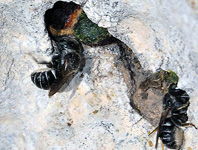Abstract
A new species of dirivultid copepod (Siphonostomatoida) is described from hydrothermal vents in a volcanic seamount in Izu-Bonin Arc, western part of North Pacific Ocean. The copepod was collected during the research cruise NT13-09 using the R/V Natsushima with the ROV Hyper-Dolphin in April 2013. The type series of the new species was collected from the populations of Paralvinella spp. (Annelida: Alvinellidae) on an active vent chimney at the depth of 795 m. Stygiopontius senokuchiae n. sp. is most closely related to S. teres Humes, 1996 but clearly distinguished from the latter species by the possession of the following characters: the basis of leg 1 with an attenuated inner process; the genital double somite with a conical process lateral to the genital opening; and caudal rami without distal process. The findings of the copepod in the present study represents the first record of nominal species of the Dirivultidae from Japanese waters and a record of the shallowest depth of the genus. A key to species of the genus Stygiopontius from Western Pacific is provided.
References
Boxshall, G.A. & Halsey, S.H. (2004) An Introduction to Copepod Diversity. The Ray Society, London, 966 pp.
Fujiwara, Y., Okutani, T. & Kimura, H. (2013) First occurrence of Alviniconcha from Japanese waters (Gastropoda: Provannidae). Venus, 71, 217–219.
Gollner, S., Ivanenko, V.N., Martínez Arbizu, P. & Bright, M. (2010) Advances in taxonomy, ecology, and biogeography of Dirivultidae (Copepoda) associated with chemosynthetic environments in the deep sea. Plos One, 5 (8), 1–13.
https://doi.org/10.1371/journal.pone.0009801Gollner, S., Stuckas, H., Kihara, T.C., Laurent, S., Kodami, S. & Martinez Arbizu, P. (2016) Mitochondrial DNA analyses indicate high diversity, expansive population growth and high genetic connectivity of vent copepods (Dirivultidae) across different oceans. PLoS ONE, 11 (10), 1–10.
https://doi.org/10.1371/journal.pone.0163776Humes, A.G. (1987) Copepods from deep-sea hydrothermal vents. Bulletin of Marine Science, 41, 645–788.
https://doi.org/10.1007/978-94-009-3103-9_63Humes, A.G. (1989) New species of Stygiopontius (Copepoda, Siphonostomatoida) from a deep-sea hydrothermal vent at the East Pacific Rise. Zoologica Scripta, 18, 103–113.
https://doi.org/10.1111/j.1463-6409.1989.tb00125.xHumes, A.G. (1990) Copepods (Siphonostomatoida) from a deep-sea hydrothermal vent at the Mariane Back-Arc Basin in the Pacific, including a new genus and species. Journal of Natural History, 24, 289–304.
https://doi.org/10.1080/00222939000770211Humes, A.G. (1991) Siphonostomatoid copepods from a deep-water hydrothermal zone in the Lau Basin, South Pacific. Bulletin du Muséum National d'Histoire Naturelle, Paris, 4, Series 13, Section A1–2, 121–134.
Humes, A.G. (1996) Deep-sea Copepoda (Siphonostomatoida) from hydrothermal sites on the Mid-Atlantic Ridge at 23°W and 37°N. Bulletin of Marine Science, 58, 609–653.
Humes, A.G. (1997) Siphonostomatoid copepods from deep-sea hydrothermal sites on the Mid-Atlantic Ridge west of the Azores. Cahiers de Biologie Marine, 38, 63–77.
Humes, A.G. & Dojiri, M. (1981) A new siphonostome family (Copepoda) associated with a vestimentiferan in deep water off California. Pacific Science, 34, 143–151.
Humes, A.G. & Gooding, R.U. (1964) A method for studying the external anatomy of copepods. Crustaceana, 6, 238–240.
https://doi.org/10.1163/156854064x00650Ivanenko, V.N. & Ferrari, F.D. (2013) New species of Stygiopontius (Copepoda: Siphonostomatoida: Dirivultidae) from a deep-sea hydrothermal volcano in the New Ireland Fore-Arc system (Papua New Guinea). Journal of the Marine Biological Association of the United Kingdom, 93, 1805–1812.
https://doi.org/10.1017/s0025315413000763Ivanenko, V.N., Martínez Arbizu, P. & Stecher, J. (2006) Copepods of the family Dirivultidae (Siphonostomatoida) from deep-sea hydrothermal vent fields on the Mid-Atlantic Ridge at 14ºN and 5ºS. Zootaxa, 1277, 1–21.
Ivanenko, V.N., Martínez Arbizu, P. & Stecher, J. (2007) Lecithotrophic nauplius of the family Dirivultidae (Copepoda; Siphonostomatoida) hatched on board over the Mid-Atlantic Ridge (5°S). Marine Ecology, 28, 49–53.
https://doi.org/10.1111/j.1439-0485.2007.00142.xJohnson, S.B, Warén, A., Tunnicliffe, V., Van Dover, C., Wheat, C.G., Schultz, T.F, Vrijenhoek, R.C. (2015) Molecular taxonomy and naming of five cryptic species of Alviniconcha snails (Gastropoda: Abyssochrysoidea) from hydrothermal vents. Systematics and Biodiversity, 13, 278–295.
https://doi.org/10.1080/14772000.2014.970673Mitarai, S., Watanabe, H., Nakajima, Y., Shchepetkinc, A.F. & McWilliams, J.C. (2016) Quantifying dispersal from hydrothermal vent fields in the western Pacific Ocean. Proceedings of the National Academy of Sciences, 113, 2976–2981.
https://doi.org/10.1073/pnas.1518395113Tanaka, H. & Yasuhara, M. (2016) A New Deep-sea Hydrothermal Vent Species of Ostracoda (Crustacea) from the Western Pacific: Implications for Adaptation, Endemism, and Dispersal of Ostracodes in Chemosynthetic Systems. Zoological Science, 33, 555–565.
https://doi.org/10.2108/zs160079Watanabe, H., Tsuchida, S., Fujikura, K., Yamamoto, H., Inagaki, F., Kyo, M. & Kojima, S. (2005) Population history associated with hydrothermal vent activity inferred from genetic structure of neoverrucid barnacles around Japan. Marine Ecology Progress Series, 288, 233–240.
https://doi.org/10.3354/meps288233Yahagi, T., Watanabe, H., Ishibashi, J. & Kojima, S. (2015) Genetic population structure of four hydrothermal vent shrimp species (Alvinocarididae) in the Okinawa Trough, Northwest Pacific. Marine Ecology Progress Series, 529, 159–169.
https://doi.org/10.3354/meps11267

